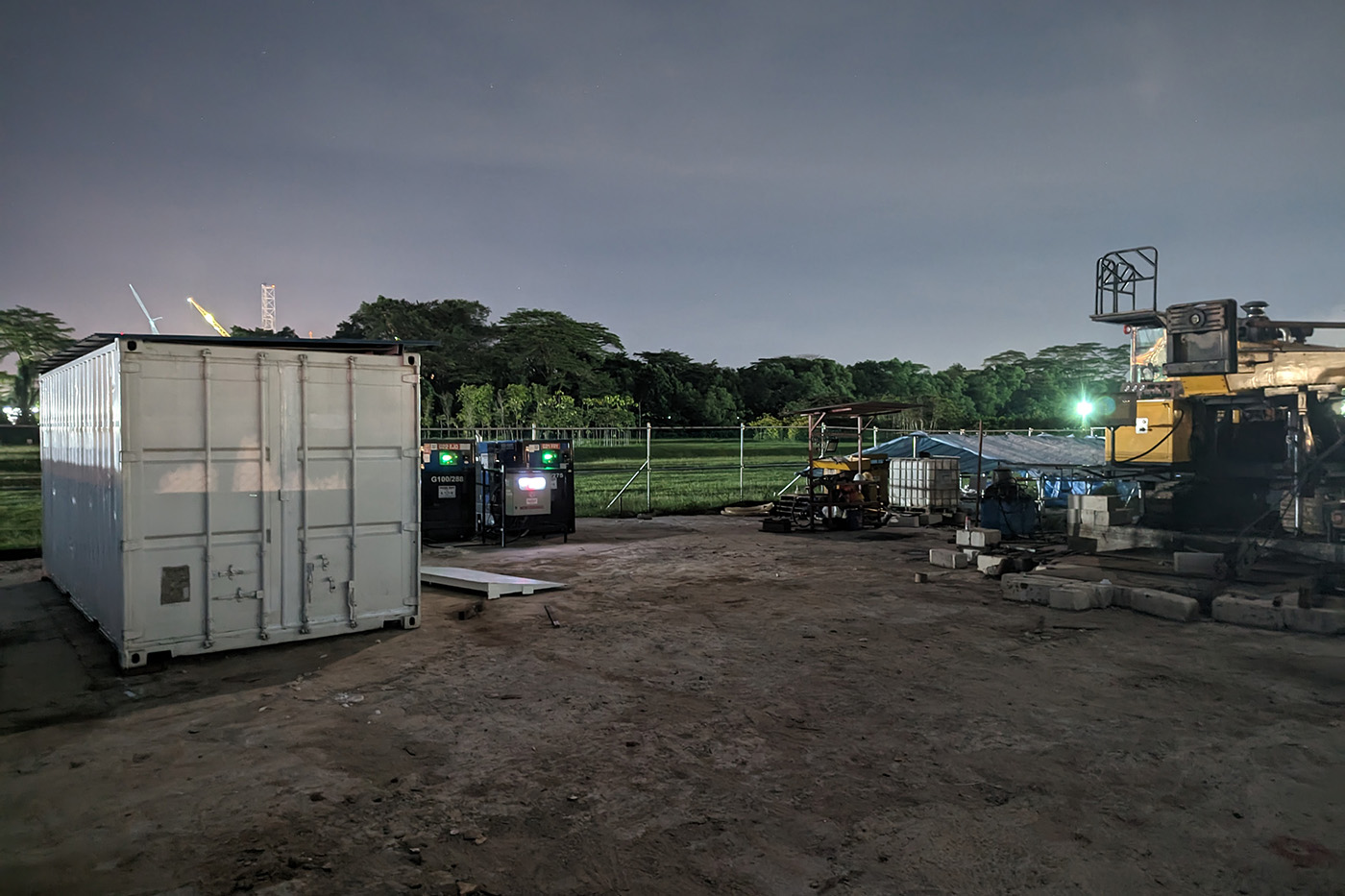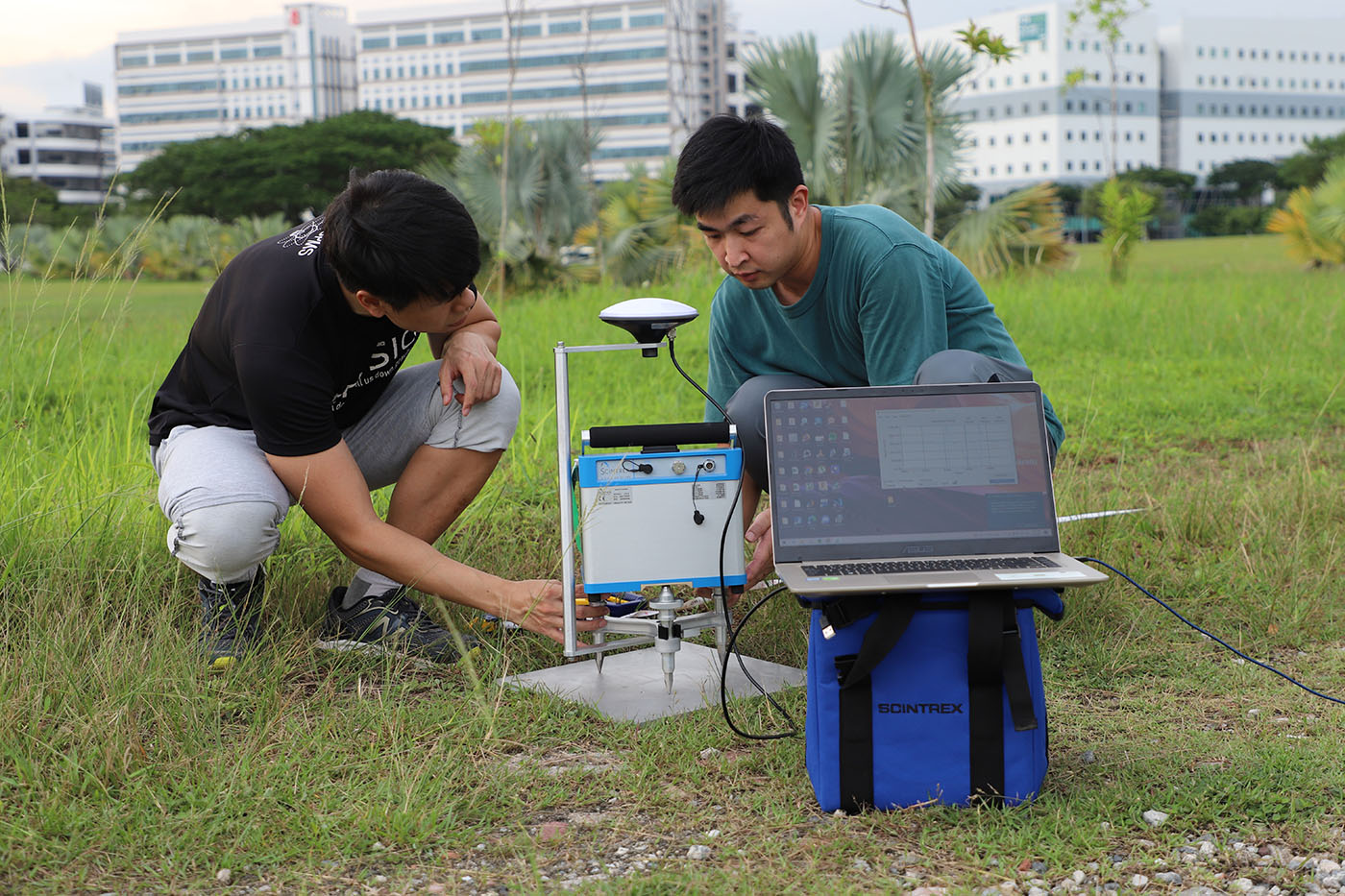Highlights
Quantum gravimeter helps check what lies underground
 Late in the evening of 2 May 2023, the gravimeter built by Rainer Dumke's group was transported to Sembawang. It is housed in the white container pictured.
Late in the evening of 2 May 2023, the gravimeter built by Rainer Dumke's group was transported to Sembawang. It is housed in the white container pictured.
Across the field, a flock of crows, javan mynas and a lone white egret took flight behind the team’s container of high-tech equipment. Here was not your usual quantum physics laboratory. The group of Principal Investigator Rainer Dumke was in the wild with its quantum gravimeter.
From 2 to 6 May, the team worked with researchers from the Earth Observatory of Singapore (EOS) to conduct a gravity survey at the Nanyang Technological University’s (NTU) Geothermal Survey Site. This happened as part of a study funded by the Quantum Engineering Programme 2.0, supported by Singapore’s National Research Foundation.
Researchers designed the survey profile across a potential fault, a fracture zone in the rocks of the Earth’s crust, which could be a potential location for fluid pathway and geothermal power generation. Preliminary seismic survey in the region conducted by EOS already shows significant velocity contrast across the potential fault zone.
The Sembawang hot springs is located just about four kilometres away from the survey site. Hot springs are formed when water seeps into faults and is heated up by the hot rock masses underground.
If their survey goes across a fault line, the researchers hypothesise they should see a decrease in gravity. The gaps between the rock masses, which could go deep underground, would mean those areas have a lower density. This in turn would causes a lower gravity signal – gravity variations in the range of a few 10 micro-Gal – but you would need precise and stable measurements to detect the small differences.
From lab to field
 The quantum gravimeter.
The quantum gravimeter.
That’s where Rainer and his team come in. They have been building various interferometers and precision sensors for more than 10 years. Technological developments from specialised lasers to precision electronics are needed to build their portable quantum gravimeter. It is about the size of a household fridge and measures the acceleration of a cloud of cold atoms as it falls inside a vacuum chamber. This gives absolute measurements of gravity with micro-Gal sensitivity, reading up to 9 decimal places.
The team transported their quantum gravimeter from NTU to the survey site by truck, installing it inside an air-conditioned shipping container.
There, the quantum gravimeter is used in tandem with smaller, hand-luggage sized classical gravimeters that the team could move around the surrounding area. These measure the effect of gravity on a measurement spring.
Preliminary data from the two types of devices showed comparable sensitivity. However, the classical gravimeter’s data drifts about 20 micro-Gal per day. The drift rate is the change in gravity readings at a fixed point over time and could be due to temperature changes or the changes in the properties of the measurement spring.
Rainer says, “We can stabilise the drift to the quantum gravimeter. What we get is a very good short-term stability from the classical gravimeter and a long-term stability from the quantum gravimeter.”
Although the container hums from the power generators and air-conditioning, the team found the gravimeter performed as well in the field as it had in the lab. “If you touch the wall of the container, you can feel it vibrating,” says Rainer. Vibration from the environment, in particular vertical movement, can affect the accuracy of the quantum gravimeter. “Surprisingly, the accuracy we get in this environment is roughly the same as in the lab. This is because of our active vibration cancellation system which I would say is fairly powerful.”
The team built an active vibration cancellation system in the base of the metal rack that houses their device. It combines a spring-mass isolation stage with an accelerometer and tilt sensors that provide feedback to three voice coil actuators. These push on the stage to cancel vertical movement and tilt.
Quantum and classical measurements
 (From left) Pictured are CQT Research Assistant Lee Kaisheng and EOS Research Fellow Chen Yukuan taking measurements with a classical gravimeter.
(From left) Pictured are CQT Research Assistant Lee Kaisheng and EOS Research Fellow Chen Yukuan taking measurements with a classical gravimeter.
The field survey area measures about 600 metres by 300 metres. The researchers split into two groups, each taking one classical gravimeter, to take measurements along the horizontal length or vertical length of the site. They stopped every 20 metres to take data, setting up the instrument to record measurements over three minutes.
After every hour of surveying, the researchers returned the classical gravimeter to the base station to calibrate their instrument to the quantum gravimeter. This means the researchers can be sure that any features later seen in the gravity data are due to geology and not to drift.
The CQT and EOS teams are now back in their university offices analysing the data. As well as looking for what the gravity data will reveal, the team will study magnetic and seismic data from the same area. They also target to do various gravity surveys in Singapore to build highly accurate gravity maps which are useful for geology but also civil engineering.
Associate Professor Wei Shengji, a Principal Investigator at EOS, said, “The combination between the relative measurements from the traditional gravimeter and the absolute measurements from quantum-sensing based gravimeter provides us the most accurate and high resolution gravity values in the study area. With these new observations, the following joint analysis with the seismic and magnetic data will be much more robust and powerful, which will be critical for us to better image the underground geological structure, including fault zone and potential geothermal structure”.
Learn more
Related Stories
 | Presenting CQT's Annual Report for 2020 April 29 2021 |
 | CQT researchers awarded grants under Singaporeās Quantum Engineering Programme April 21 2022 |






